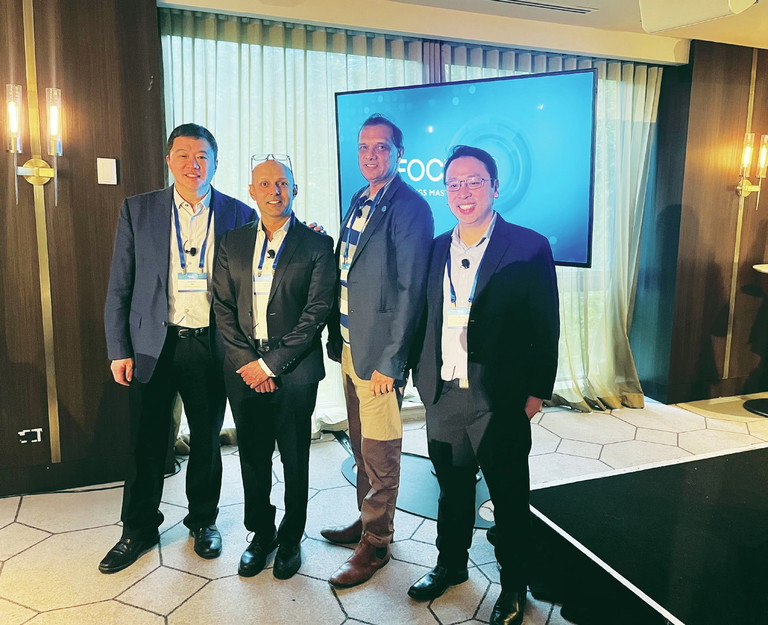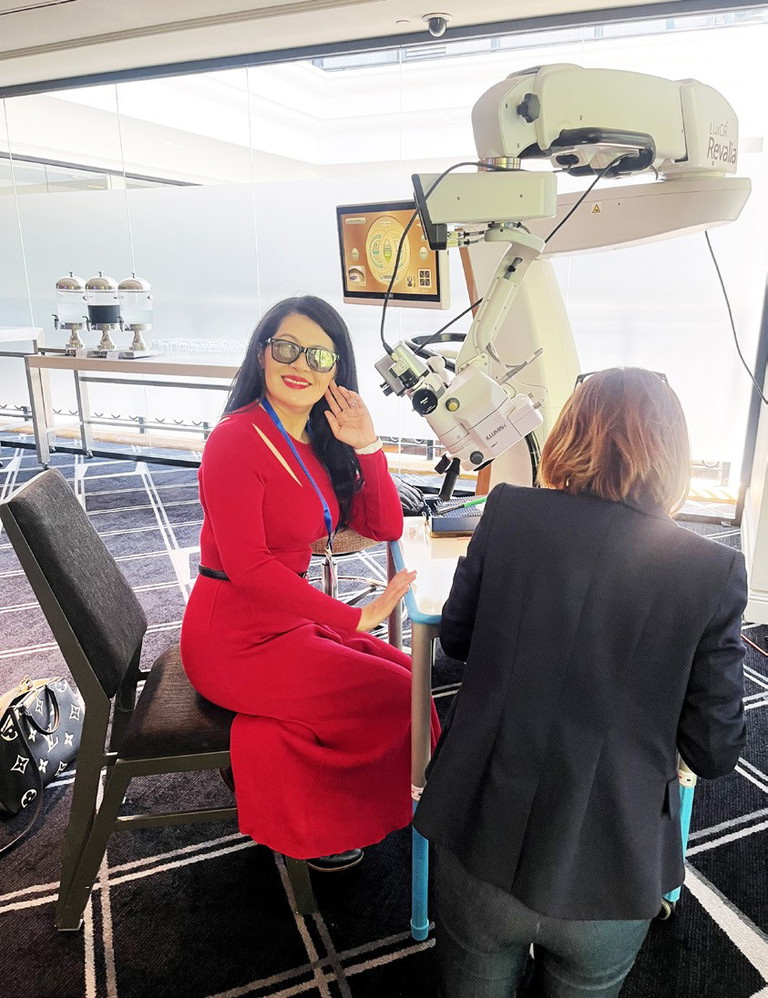mievent
Focus Alcon’s MIGS Masterclass

From left: Professor Graham Lee, Associate Professor Shamira Perera, Associate Professor Ashish Agar, and Assistant Professor Bryan Ang.

Associate Professor Judy Ku.
When it comes to minimally invasive glaucoma surgery (MIGS) devices, Australian ophthalmologists and their patients are currently spoiled for choice. And as a group of ophthalmologists attending a MIGS Masterclass in Sydney recently heard, that choice usually comes down to what the practitioner feels most comfortable – and confident – working with. Late last year, Alcon set out to broaden surgical horizons with an entire day focussed on achieving optimal outcomes with the Hydrus Microstent.
WRITER Melanie Kell
Made from nitinol and about the size of an eyelash, the Hydrus Microstent is a canal-based MIGS device for adult patients with mild to moderate primary open-angle glaucoma.
With an “open scaffold design”, it bypasses the trabecular meshwork to span approximately 90° of Schlemm’s canal, ensuring access to collector channels in the nasal region.1 Initially funded under the Medical Benefits Schedule (MBS) for use in conjunction with cataract surgery, MIGS is also MBS funded as a standalone procedure.
Delving into the detail of implanting this impressive miniscule device were four acknowledged experts in glaucoma: Associate Professor Shamira Perera and Assistant Professor Bryan Ang from Singapore; and from Australia, Associate Professor Ashish Agar and Professor Graham Lee.
Armed with analogies from Back to the Future and Bush Mechanics, Assoc Prof Agar managed to both entertain and inform the audience with compelling insights. He reported that patient outcomes from Hydrus implants are excellent, both in clinical studies and real-world settings.
HORIZON is the largest prospective, randomised, controlled MIGS pivotal trial to date with 556 patients at 38 centres in nine countries.2 This study found, “the rate of surgery required at five years was effectively half ” in patients implanted with the Hydrus at the time of cataract surgery, compared to patients who underwent cataract surgery alone. Furthermore, Assoc Prof Agar reported 72% of patients who underwent cataract surgery with the Hydrus implant were medication free and had reduced intraocular pressure (IOP).2 Later, Prof Lee added to the good news, reporting that the implant did not adversely affect the corneal endothelium compared with phacoemulsification alone in the longer term.
However, clinical data can differ from that collected in real world settings and Assoc Prof Agar, who is the medical director of the Outback Eye Service in Western New South Wales, said that initially, he was not prepared to take this new technology to outback NSW on the basis of HORIZON alone.
“Essentially before you go out into the outback, you’ve got to ask yourself how much are you going to be experimenting? Do I have confidence in new technology?”
He was finally convinced to use the Hydrus after comparing “unparalleled” real world data collected from every patient implanted with Hydrus in Australia and New Zealand (the SPECTRUM study), along with outcomes he and colleagues collected from a multicentre study conducted in Sydney.3 Both studies achieved results that were similar to HORIZON, with reductions in IOP, requirement for medication and need for subsequent surgeries. On the basis of data collected over three years he said, “I was happy to basically take it out bush” and in 2017–18, “I finally achieved my four-year dream of being able to provide a safe reliant procedure in a remote location”.
Assoc Prof Agar said MIGS has “turned glaucoma management on its head”, enabling patients with mild to moderate primary openangle glaucoma, who are intolerant to drops or have not responded to medication and laser, to be treated effectively, and in doing so delaying or even negating the need for more invasive trabeculectomy or tube shunt surgery.
He urged surgeons in the room to contribute case data to the Fight Glaucoma Blindness! Registry. This data collection is essential to demonstrate to government the continued efficacy of interventional glaucoma management. Additionally, he said the data will eventually enlighten the profession on outcomes achievable from different MIGS devices.
SUCCESS: ALL ABOUT TECHNIQUE
Across the day the surgeons in the room – some who were new to MIGS, others who were seasoned practitioners – were treated to a number of videos demonstrating successful and not so successful MIGS techniques. They were then invited to participate in frank and open discussion about potential complications, and to share useful tips for surgical and post-operative management.
As Assist Prof Ang said, “There’s no perfect surgery. Every surgery has a learning curve and even after you’ve done a lot of cases, we still have situations which are sticky that we need to get out of.”
The key to success, Prof Lee said, is to be comfortable with the device because “if you’re comfortable with the device, you can make it work”. He assured attendees that “once you get over the initial learning curve” the Hydrus is efficient to use and precisely position, which leads to excellent outcomes.
Observing the reality of operating in the bush without the back up of surgical colleagues, Assoc Prof Agar agreed, saying “the clincher for me is that I can fix it if I’m concerned”.
Assist Prof Ang encouraged attendees who have not used the Hydrus yet to give it a go. While it can be easy and more convenient to continue doing what you know, he said surgeons must make the effort to learn new procedures that are demonstrating good patient outcomes and take the time to do the procedure well.
“As I always tell my fellows, it is beholden on us as surgeons to make sure that if we bring the patient to the operating room, we leave the operating room being confident that we’ve done the very best we can for the patient in terms of stent placement.”
For surgeons beginning their Hydrus journey, Assoc Prof Perera concluded that “the most important thing is preparation” and to “get your gonioscopy skills up”.
Echoing the sentiment, Prof Lee advised, “Get yourself comfortable, get yourself a good view and you’ll have success… without a good view, you cannot place the stent”.
TRIALLING THE NGENUITY
During breaks in the Masterclass, surgeons were able to try their hands at implanting the Hydrus with the aid of Alcon’s Ngenuity 3D visualisation system.
Associate Professor Judy Ku, who had travelled from Queensland to attend the workshop “out of curiosity”, said this was an excellent opportunity to appreciate both the practical tips offered regarding insertion angles and complication avoidance, while also realising the unique advantages of Ngenuity.
The system’s heads-up display is ergonomically advantageous, while its 3D visualisation with filters to outline the anatomy of the eye, enhances depth perception; all together making microsurgery easier to perform.
“I think ergonomics, health and wellbeing is a huge thing now for ophthalmologists,” Assoc Prof Ku observed.
Noting the benefits of diverse international perspectives offered across the day, Assoc Prof Ku said, “most useful were all the videos, particularly the ones that demonstrated managing tricky situations, angles for insertion of the Hydrus, managing bleeding and scarring, and also how to avoid complications”.
References available at mivision.com.au.